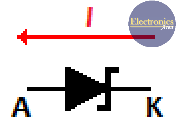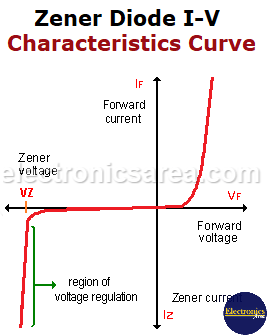Home / Semiconductors /
What is a Zener diode?
The Zener diode is a special type of diode that allows the flow of current on the opposite direction of the arrow of the diode. This diode does not conduct until the applied voltage reaches or is greater of the breakdown voltage. This voltage is the “zener voltage”.
Note: This diode works like a common semiconductor diode when it is forward biased.
The following picture shows the symbol of the zener diode (A – anode, K – cathode) and the direction of the electric current when the zener diode operates in the region of voltage regulation.
Basic Operation
The Zener diode will be analyzed, not as an ideal diode but as a real one. When this diode is in reverse biased, a small amount of electric current flows throughout the diode.
When we analyze the diode curve, we can see that when the voltage applied to the diode is increasing (negatively), the flowing current does not increase a lot. However, once the applied voltage reaches a voltage value called Zener voltage (Vz), the voltage does not increase a lot so it can be considered constant.
The current that passes through the diode (zener current), can vary in a large range of values, but the voltage on the diode is almost the same. This region is called: region of voltage regulation. This is the feature of the zener diode that we can take advantage of, because the voltage stays practically constant for a great current variation. See the picture above.
Zener Diode Applications
Zener diodes are used as:
- Voltage reference elements
- Surge suppressors
- Voltage regulation
- Surge suppressors
- In clipper circuits
- etc.
One very popular application is as a voltage regulator. A regulator with an ideal zener diode maintains a fixed predetermined output voltage, regardless of the variation of voltage on the power supply and / or the load. However, the voltage source is not ideal, and it is common that the output voltage decreases as the load goes up. (the electrical current raises).
Note: The output voltage doesn’t change as the load changes in an ideal voltage source.
You may be interested in how to test a zener diode.






